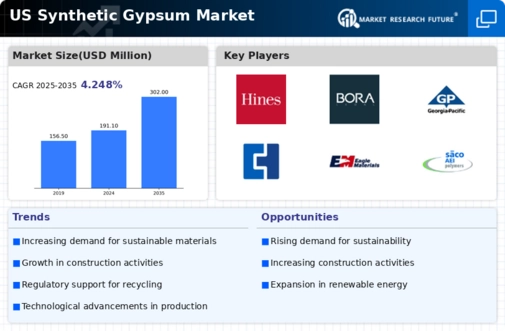The US Synthetic Gypsum Market has developed significantly over recent years, driven by the increasing demand for sustainable construction materials and the growth of the drywall industry. As stakeholders across various sectors recognize the environmental benefits of using synthetic gypsum, including its role in recycling and reducing landfill waste, the competitive landscape has become increasingly dynamic. Market players are focusing on innovations and advancements in product quality and application methods to capture a larger share of this thriving market.
The rising desire for eco-friendly alternatives has also motivated companies to explore strategic partnerships and collaborations while enhancing their operational efficiencies to sustain competitive advantages.Hines has established itself as a prominent player within the US Synthetic Gypsum Market, leveraging its extensive knowledge and experience in the industry. The company has been recognized for its commitment to sustainability and innovative practices. This approach enables Hines to offer high-quality synthetic gypsum products that meet the accelerated demand of the construction sector. The company's strong reputation in customer service and continuous product improvement enhances its market position.
Furthermore, Hines benefits from well-established distribution channels across the United States, allowing it to maintain a robust presence in key geographic regions. This comprehensive strategy positions Hines favorably against its competitors and enables it to effectively respond to evolving market trends and customer needs.Gyptech is another key player within the US Synthetic Gypsum Market, known for its specialized offerings pertaining to the production and processing of synthetic gypsum. The company's core products include advanced gypsum processing systems and its expertise in gypsum wallboard manufacturing.
Gyptech possesses a strategic edge over competitors due to its advanced technological solutions and focus on operational excellence. With a solid market presence, Gyptech has been actively engaged in mergers and acquisitions that bolster its capabilities and extend its geographical reach within the United States. This commitment to growth not only strengthens Gyptech's offerings but also enhances its competitive advantages, making it an influential contributor to the synthetic gypsum sector in the U.S. As the market continues to evolve, Gyptech's innovative approach and strong emphasis on quality positions it well for sustained success in the synthetic gypsum landscape.


















